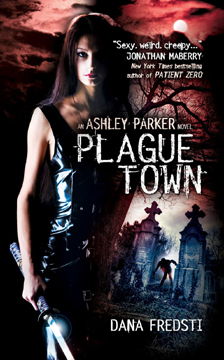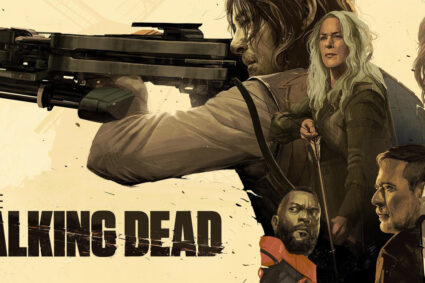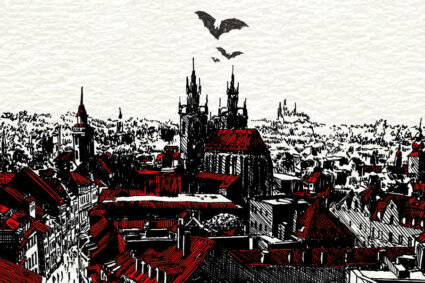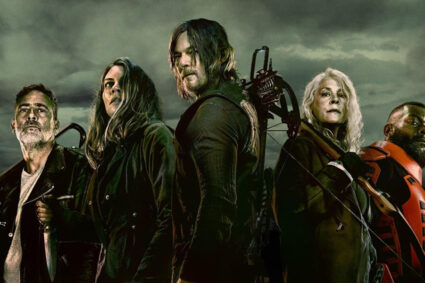
Dana Fredsti is many things. She’s the proverbial “Jill” of all trades. She’s a screenwriter. She’s an actress, playing among other roles, a sword-wielding deadite in Army of Darkness. She’s an advocate for at-risk felines, big and small. She’s a wine connoisseur. She’s a nonfiction essayist. She’s even penned paranormal erotica in the guise of her alter ego. Through her myriad eclectic endeavors, she’s always harbored an attraction to genre storytelling, zombies in particular. And if these stories happen to feature a strong female protagonist, all the better.
Recently, Fredsti has joined the ranks of artists, writers, and filmmakers who’ve made significant contributions to the ever-expanding fictional universe in which zombies eat the flesh of the living and survivors, well, survive. Her book, Plague Town: An Ashley Parker Novel (Titan Books) is a funny and gross blitz through the zombie apocalypse as experienced by Ashley Parker, a late-twenties divorcee who’s trying to survive college and, later, zombies.
Ashley is a wild card, someone who’s immune to the zombie plague and, in fact, gains some rather extraordinary abilities following her first zombie encounter. The results make for an addicting page turner that will leave you wanting more time to hang out with Ashley and her pals. Luckily, there are two more Plague books coming. So, move over Buffy and step aside Ripley. Ashley is here and Ravenous Monster caught up with her creator to get the goods on all things Plague Town as well as what makes Dana Fredsti tick….
RavMon: What was the impetus for Plague Town?
Dana Fredsti: The impetus for Plague Town was Ms. Lori Perkins with Ravenous Romance. Lori called me one day and asked if I’d be interested in developing and a series of books that were essentially pitched to me as “Buffy. But with zombies. And different.” Being a Buffy fan, a zombieholic (can’t stop at just one!), and someone who doesn’t mind an interesting creative challenge, I said yes and started writing.
RavMon: How did Titan Books get involved?
DF: Divine intervention in the form of the lovely Lori shopping the series. Steve Saffel (now my beloved Dark Editorial Overlord) was interested and things went from there. I have to say both Ravenous and Titan have been very good to me.
RavMon: Why zombies? It seems like a bit of a departure from your previous books, your Inara LaVey material in particular.
DF: Actually three of my published short stories are actually zombie stories. The first, A Man’s Gotta Eat What a Man’s Gotta Eat, was in Danger City, a very cool urban noir anthology put out by Contemporary Press. I have the distinction of being the only female author in that anthology and when I showed up at the launch party, they were surprised to find out I wasn’t a guy, Dana being a unisex first name. The second, You’ll Never Be Lunch in this Town Again, was in John Skipp’s Mondo Zombie anthology. The third, First Date, was in Hungry for Your Love, a…er… zombie romance anthology published by Ravenous and then picked up by St. Martin’s Press. I wrote that under my real name as opposed to my erotic romance pen name, Inara LaVey, because I was working on the first Ashley book at the time. So… as you can see zombies have been a theme in my writing for quite a while.
RavMon: What was it like, then, tackling a full on zombie novel? From my perspective, the plague develops almost like another character in your novel, and while I haven’t had the opportunity to read your zombie-centric short stories, I assume you sort of had to “hit the ground running” in those with regard to the plague. Is that accurate?
DF: Tackling a full on zombie novel was just plain fun. I love your comparison of the plague in my story developing like a character, and while I didn’t think of it that way while I was writing, I’ll take it as a sign I was successful in gradually revealing my particular take on zombie outbreaks. As far as writing the short stories, I didn’t address how the plague started. The first, A Man’s Gotta Eat What a Man’s Gotta Eat is narrated by a detective who is already a zombie. So I do basically just hit the ground running and assume the readers have seen Dawn of the Dead. Except for the fact my zombies in this are pretty much sentient. They just have a new diet. I actually love this story. My favorite review “sound byte” of it is:
‘What would happen if Raymond Chandler and Frank Miller conceived a child in a cheap motel room while a Romero marathon played in the background? Dana Fredsti’s, A Man’s Gotta Eat What a Man’s Gotta Eat.’
You gotta love that, right? And it’s a fair description. The second story, You’ll Never Be Lunch in this Town Again, I basically just dive in there as well and assume my readers know enough about zombies to not be spoon fed the mythos. Since it’s in a John Skipp anthology, I think that’s a fair assumption to make.
RavMon: Plague Town succeeds by every measure. However, our review alludes to a malady that’s afflicted a large segment of horror fans the last couple of years. It’s known as “zombie fatigue”. Were you worried about that before embarking on writing a zombie novel, the first of a trilogy, no less? Were there any discussions with Titan Books about how to approach or market the book to make sure the targeted demographic (huge nerds like me) would give it a shot?
DF: Well, first of all, thank you for the first part of the above paragraph! As far as zombie fatigue, I am my own target audience and I’m not tired of zombies at all yet so I know there are others out there just like me. Steve Saffel liked the original material and felt it would find a mixed audience (huge nerds like you and me too, for that matter, and readers of urban fantasies with kickass heroines) and just worked with me to make the book the best possible book it could be. If there were discussions on how to market it, I wasn’t privy to them. But I sure am impressed and overwhelmed by the work that the Titan publicity teams in the U.K. and the U.S. have done for Plague Town.
RavMon: Nearly every notable zombie story treats the zombie apocalypse as a metaphor, a vehicle for social commentary and/or cultural satire, beginning with Romero’s 1968 zombie apocalypse archetype and continuing through AMC’s The Walking Dead (and its source material). The zombie apocalypse could just as easily be a nuclear winter, a pandemic, etc. and it would function just the same: A plot device used to force characters from disparate walks of life into a cohabitation in which they’re forced to compete for limited resources. Some characters use cooperation as a survival tool, while others pillage and plunder. All the while everyone suffers from the stress of the omnipresent danger that’s shuffling through the streets, the fields, and the forests. Inevitably, the survivors split off into protagonists and antagonists and it becomes people, not zombies that our heroes need to fear most. Plague Town is the first zombie story I’ve come across in a really long time that strays from that symbolic paradigm. It’s refreshing. And if such a metaphor does exist in your book, it’s the anti-plague paramilitary group that functions symbolically, not the shambling horde. Could you speak on this a bit? Was this a conscious decision?
DF: Dang, boyo, your questions are longer than most of my answers! And you’re more eloquent! And… er… let me see if I have the question straight here… You’re saying I use zombies as zombies as opposed to a metaphor for something else, yes?
RavMon: Exactly. And, yeah, some of my questions are like that weird uncle lurking at every holiday gathering — just sort of obnoxious and uncomfortable, but well-meaning. I apologize for that and, honestly, it’s best to remember to just smile and nod in agreement. Eventually my question will end and we’ll both be no worse for wear. But you do use zombies as zombies?
DF: Yes, I do. I love zombies because they’re freaky scary monsters. They’re our friends and neighbors with no humanity left and they want to eat our flesh and rip us apart while we’re still alive. That’s enough horror for me right there without adding in any subtext. I don’t even know if the wild cards and the DZN (the ancient organization of zombie killers) are any sort of symbol for anything. They’re a fun plot device and my way of showing that zombies have been around pretty much as long as humanity. So… no conscious decision to avoid symbolism and metaphors, although who knows what people might read into it? I am not a particularly subtle person. My writing is pretty much what it is. Sometimes a cigar is just a cigar and sometimes a banana is just a banana. And sometimes a zombie is just a stinky flesh eating walking dead thing.

RavMon: Plague Town features a female protagonist, a fantastic one in Ashley Parker. However, gender issues are only present because of Ashley’s inherent woman-ness (I just made that up, by the way). You’ve avoided meting out heavy-handed sociology from atop a soap box, rather allowing these issues to persist organically in your book. The way these issues play out in Plague Town rings true, as does your portrayal of the male characters. What’s your take on gender issues in the horror genre at large, in Plague Town, and the way you’ve approached writing male characters?
DF: I like “woman-ness”. I may steal it. You don’t mind, right?
RavMon: I’d be honored….
DF: As far as gender issues in horror, I don’t like it when female characters are relegated to the support/bitch/victim roles. That being said, I don’t see any need in my writing to step up on a soapbox and make a big deal out of these things. That tactic annoys me when I read it in a book or see it in a movie so I try to avoid it when I write. It’s easier and more effective to just create strong female characters and equally strong male characters for them to interact with, all of them with their own flaws and foibles. A lot of my characters, male and female, are based on people I know, so the male characters are as real to me as the female. Where you might see a bit of soapbox in my writing would always be where animals are involved. “If you want to live, don’t go back for the cat. If you want to live with yourself, go back for the cat.”
RavMon: As you’ve stated, Ashley is sort of an older, less isolated version Buffy character. Did any other female-centric horror inform Plague Town?
DF: Buffy and Ripley definitely inform Plague Town (you should have SEEN those two lecture me while I was writing), and just my own definition of what makes a good action heroine.
RavMon: Which one of the abundant male horror icons in pop culture history would have been more interesting had he been a woman?
DF: Well, Ash in Army of Darkness would have been interesting. Maybe not MORE interesting, but I would have loved to have seen how a female would have handled herself thrust back in medieval England (well, England set in the middle of a desert…). And what if Michael Myers had been Michaela Myers? I do love the fact that Ripley was originally written for a male actor. I think the part was so much more interesting given what Sigourney Weaver brought to it as an actress and a woman than it would have been had it been played by a man. I don’t know if I actually answered your question, but there you have it!
RavMon: Speaking of Ash, on the set of Army of Darkness you were an armourer’s apprentice. Two things: First, that sounds infinitely cooler than gaffer, grip, or best boy. Second, what is an armourer’s apprentice?
DF: I was actually also a sword fighting Deadite and a sword captain, but yes, my first job on the film was as the onset armourer’s assistant. That consisted of helping distress (make look old/real/used, not upset) plastic armor worn by the extras, repairing broken buckles, belts, grommets, and help the extras get dressed in their ginchy distressed armor. And I do think it’s cooler than being a gaffer, grip OR best boy!
RavMon: Do you have any screenwriting projects or other movie-making opportunities planned?
DF: I’m currently working on an interesting “reality” show with Brian Thomas (who was the onset armourer on Army of Darkness) and Mark Worman, head of The Division Productions. It has something to do with zombies. I can say no more at this time. Other than that, one screenplay optioned and others sitting in a drawer because I’m too busy with Plague Town and Plague Nation to worry about ’em.
RavMon: What were the stories that inspired the young Dana Fredsti down a path that inevitably arrives at zombies?
DF: Oh jeez… I always loved non-fiction books about vampires, werewolves, natural disasters, cannibals, you name it. And the stuff in kid’s books that fascinated me were things like the giants of Harfang in C.S. Lewis’s The Silver Chair because they ate people, the Cauldron Born in Lloyd Alexander’s Prydain Chronicles, Grimm’s Fairy Tales with all the flesh-eating witches and monsters. Then there were all the fun horror films on Saturday afternoons, not to mention Dark Shadows. If it was morbid, scary and at all icky, I loved it. Then I saw the original Dawn of the Dead as my first date movie. My fate was sealed.
RavMon: What about horror intrigues you and are you comfortable with being labeled a horror writer?
DF: I like being scared. It’s very hard to do these days, so I really appreciate a movie or book that gets to me enough to make me want to turn on the light in the middle of the night when I have to use the bathroom or get a drink of water. I am a naturally optimistic person so maybe horror is my way of having balance in my life. Or maybe I just like being scared. And people can label me any way they’d like, although considering the wide variety of genres I’ve dabbled in, I’m not sure if any particular label will stick. I am proud to currently be labeled a horror writer, that’s for sure!
RavMon: You’re a renaissance woman so this question may be moot, but if not writing, what’s your dream job?
DF: Anything that allows me to a: wear my pajamas as long as I want to and b: go for beach walks in the morning. Or working in a wine tasting room or wine bar because I love wine and I love talking to people about wine. If there was a wine bar where I could work in my jammies, I’d be in total heaven!
RavMon: Two of my favorite people in the world are actually cats. They’re names are Mel and Sprite (AKA Baby Girl). You’ve done some outstanding work with finicky-furry-friends of all shapes and sizes. Could you please tell us about that?
DF: Let’s start with big cats. www.cathouse-fcc.org. That is the website for the Exotic Feline Breeding Compound/Feline Conservation Center in Rosamond, California, where I spent many happy hours volunteering to help save various species of felines from going extinct. At least a day a week for many years before I moved up north. Now I go down a few times a year to volunteer at their fund raisers. EFBC is one of the top breeding facilities in the world, part of a captive breeding program for exotic felines that are dying out in the wild. I’ve been kissed by a tiger, held an incredibly rare baby Amur leopard cub, had a full grown Chinese leopard sit on my foot, and been drooled on by an ocelot. Working there changed my life and kept me sane through several difficult years.
As far as the smaller, domestic cats, my boyfriend and I have fostered many kittens and cats pulled from shelters with a high kill rate. We’ve found homes for many of them, lost a few to disease, and kept a few of ’em in the general populace here. If I could save every cat in the world I would. I’d love to do the same for dogs, but we just don’t have the room.
RavMon: What can you tell us about the future of Ashley Parker?
DF: She’s got at least two more books in which to kick zombie ass. It’s not going to be easy for her and each book will up the stakes as far as the spread of the zombie plague and what Ashley has to lose on a personal level. But she will never lose her sense of humor!
3 thoughts on “Interview with Plague Town Author Dana Fredsti”
Comments are closed.















This was such a fun interview to do! Thank you, Jason!
I couldn’t agree more, Dana. It was a pleasure. Thanks very much!
Nice